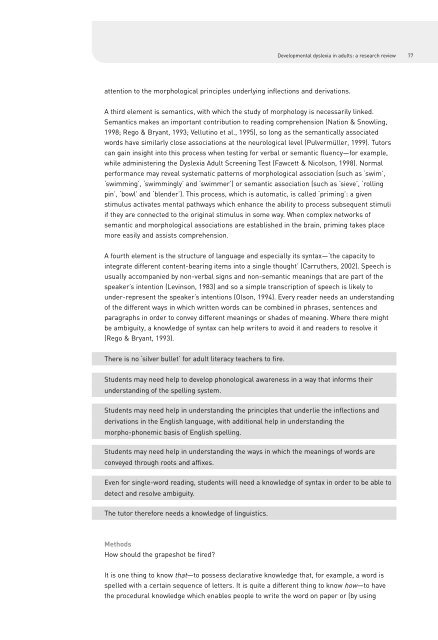01 NRDC Dyslexia 1-88 update - Texthelp
01 NRDC Dyslexia 1-88 update - Texthelp
01 NRDC Dyslexia 1-88 update - Texthelp
Create successful ePaper yourself
Turn your PDF publications into a flip-book with our unique Google optimized e-Paper software.
Developmental dyslexia in adults: a research review 77<br />
attention to the morphological principles underlying inflections and derivations.<br />
A third element is semantics, with which the study of morphology is necessarily linked.<br />
Semantics makes an important contribution to reading comprehension (Nation & Snowling,<br />
1998; Rego & Bryant, 1993; Vellutino et al., 1995), so long as the semantically associated<br />
words have similarly close associations at the neurological level (Pulvermüller, 1999). Tutors<br />
can gain insight into this process when testing for verbal or semantic fluency—for example,<br />
while administering the <strong>Dyslexia</strong> Adult Screening Test (Fawcett & Nicolson, 1998). Normal<br />
performance may reveal systematic patterns of morphological association (such as ‘swim’,<br />
‘swimming’, ‘swimmingly’ and ‘swimmer’) or semantic association (such as ‘sieve’, ‘rolling<br />
pin’, ‘bowl’ and ‘blender’). This process, which is automatic, is called ‘priming’: a given<br />
stimulus activates mental pathways which enhance the ability to process subsequent stimuli<br />
if they are connected to the original stimulus in some way. When complex networks of<br />
semantic and morphological associations are established in the brain, priming takes place<br />
more easily and assists comprehension.<br />
A fourth element is the structure of language and especially its syntax—‘the capacity to<br />
integrate different content-bearing items into a single thought’ (Carruthers, 2002). Speech is<br />
usually accompanied by non-verbal signs and non-semantic meanings that are part of the<br />
speaker’s intention (Levinson, 1983) and so a simple transcription of speech is likely to<br />
under-represent the speaker’s intentions (Olson, 1994). Every reader needs an understanding<br />
of the different ways in which written words can be combined in phrases, sentences and<br />
paragraphs in order to convey different meanings or shades of meaning. Where there might<br />
be ambiguity, a knowledge of syntax can help writers to avoid it and readers to resolve it<br />
(Rego & Bryant, 1993).<br />
There is no ‘silver bullet’ for adult literacy teachers to fire.<br />
Students may need help to develop phonological awareness in a way that informs their<br />
understanding of the spelling system.<br />
Students may need help in understanding the principles that underlie the inflections and<br />
derivations in the English language, with additional help in understanding the<br />
morpho-phonemic basis of English spelling.<br />
Students may need help in understanding the ways in which the meanings of words are<br />
conveyed through roots and affixes.<br />
Even for single-word reading, students will need a knowledge of syntax in order to be able to<br />
detect and resolve ambiguity.<br />
The tutor therefore needs a knowledge of linguistics.<br />
Methods<br />
How should the grapeshot be fired?<br />
It is one thing to know that—to possess declarative knowledge that, for example, a word is<br />
spelled with a certain sequence of letters. It is quite a different thing to know how—to have<br />
the procedural knowledge which enables people to write the word on paper or (by using
















